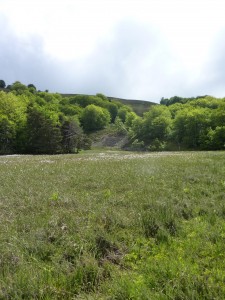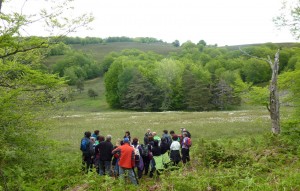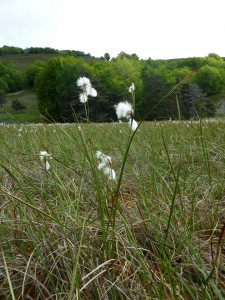Enclave Name: Anue wetland
Protection Categories: Included in LIC ES2200018 Belate. It is catologued as Undevelopable Land of Protection for is Environmental Value, Wetlands in Spatial Plan 3 “Central area”.
Emplazamiento: Anue.
Region: Navarra.
Reference Coordinate: 30TXN15.
Wetland Surface: 2´74 hectáreas.
Altitude: 900 m.
This enclave is located in an area of West facing slope, where the visible sources of water and a landing that is at the foot of these slopes meet.
The slopes are not homogeneous, the central area is drier , possibly due to lower soil depth to the bedrock, allowing the development of heath – fern with Scots pine. Meanwhile, the side areas are more damp, with development of swampy areas and the presence of Eriophorum angustifolium.
The landing is covered by a relatively homogeneous vegetation with large development of sphagnum curtains, Eriophorum angustifolium and Erica tetralix. There are two distinct areas, the Southernmost, which is the most extensive and flat, and where the peat deposit probably reaches further depth. This area has a diffusive stream, except on the Southern edge, where they develop rushes of Juncus effusus. The flat area situated further North occupies an area with a bit more of a slope than the North, allowing the development of a central channel flow. Both areas are merged towards a W just before abruptly ending in a jump on the lower slope, defined as a stream without flooded areas.
There is a special point where waters from the slopes and from central zone converge, which causes it to always be found very swampy and dominated by sphagnum curtains.
The presence of Scots pine and birch on the edges most influenced by the water of this should be noted.
- MORE RELEVANT FEATURES
Singularity
It is one of the most important peatlands of Navarra, one of the two unequivocally active.Biologic and Ecologic Features
The vegetation of the flooded areas, described as Eriophoro angustifolii-Sphagnetum Rubelli, and the presence of a community of Rhynchospora alba stand out. The presence of Pinus sylvestris and Betula pubescens subsp. celtiberica, are to be reviewed as it could be considered close to a wooded bog (91D0 *) but extremely depleted for climate and orientation reasons.With regard to plant species, the presence of Trichophorum caespitosum subsp. germanicum, Eriophorum angustifolium and Cephalozia connivens are to be reviewed (hepatic indicative of old peat environments).
Historic and Paleo-ecologic Features
The enclave has a deep peat deposit (over two meters), but is unstudied.Habitats of Community Interest
Hábitat Nombre 4010 Brezales húmedos atlánticos septentrionales de Erica tetralix 6410 Prados con molinias sobre sustratos calcáreos, turbosos o arcillo-limónicos (Molinion caeruleae) 7140 «Mires» de transición 91D0* Turberas boscosas Flora
This enclave is quite poor in diversity of vascular flora; the most notable is the abundance of Eriophorum angustifolium and Rhynchospora alba, and the presence of Trichophorum caespitosum subsp. germanicum in the flooded areas of the slopes. 31 taxa of cormophytes and 8 of bryophytes were detected (5 of them sphagnum).Fauna
This enclave the common lizard (Zootoca vivipara) can be found, classified as “Near Threatened” by the IUCN, and included in the List of Species of Special Protection Scheme statewide.- PHOTOS






